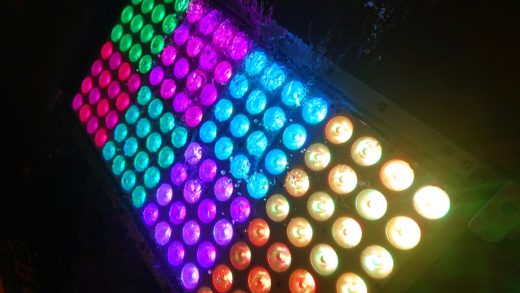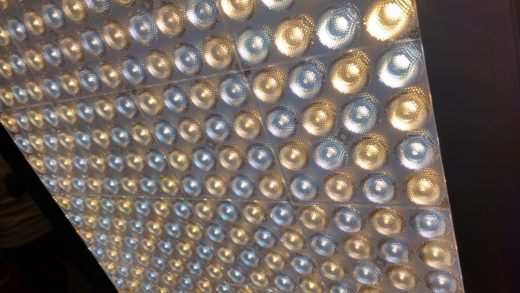
Pocketsized cameras and laptops containing the equivalent of an entire late-90s post production facility have made it easy for the old hands to lecture the young bloods about how good they have it. As the easy availability of sheer picture quality (and LED lights) becomes a decades-established normality, greybeards will have to stop wagging their fingers – but even in 2023, there are still some gaps in the equipment lineup that don’t make a lot of sense.
On that basis, this series represents your correspondent’s shameless abuse of his position to complain about things which he’d like to exist, but which, for some reason, nobody wants to sell. The first among them is a piece of lighting equipment which used to exist, but which has fallen out of favour as power levels have grown.
Tungsten-balanced LED lights
Daylight-balanced LED lights are, usually, a bit more efficient than HMIs. They’re also dimmable in ways HMIs aren’t, maybe a bit more physically robust. Battery power is an implementation detail which small HMIs might have implemented just as easily, but it’s still more present on LEDs. It’s a great technology. Still, the basic performance offset isn’t night and day. It’s heresy to say so, but there’s an argument argument daylight LEDs, despite their huge success, don’t do much that can’t be at least approximated with an HMI.
Tungsten LEDs, on the other hand, actually do something that isn’t available anywhere else – or they would if they were more common. Fluorescent tubes and metal halide lights can do tungsten-like things, and there were once HMI-compatible bulbs, presumably using metal halide technology, which could output warmer light. All those things seem to have gone end-of-line as LED takes over – but LED mainly replaces the daylight options, not the tungsten. Overlooking LED, the only way of making light in, say, the range of 2800 to 3800K is currently a lump of superheated tungsten, or maybe one of the last few fluorescent tubes that remain unsmashed.
Let’s be clear that colour mixing lights are wonderful. The fact that Rosco bought DMG seems to indicate Rosco’s interest in ensuring its own survival given an expectation that colour mixing lights might obviate gels. That’s a welcome development for anyone who’s ever stood in a rainstorm with a rack of one-eighth colour correction filters, trying to get a couple of big HMIs to match; colour mixing LEDs can drift at least as much with use but they are more likely to be self-correctable.
That sounds like a solution, but great as colour mixing options are, they’re also less effective in various small ways than fixed-output devices.

Why it matters
They’re expensive because they’re complicated, but colour mixing lights (and bicolour designs) are generally less powerful than fixed-output devices. Aputure’s LS 600X doesn’t give away much compared to the 600D, but it doesn’t have quite the same brightness. The emitting area tends to be smaller on fixed-colour devices, because there are fewer emitters and less reason to diffuse the output for colour blending. That can mean they drive modifiers such as Fresnel lenses or projection devices more efficiently, and create a sharper shadow that’s easier to cut and shape. Manufacturers, of course, know all this, and fixed-output LED lights are therefore common.
It’s just that most of them are daylight-balanced, and that has downsides of its own. Taking a blue LED and using a phosphor to convert some of its output to yellow combines with the residual blue to create white light. Taking that same blue LED and converting more of its output to yellow creates white light with lower colour temperature and, coincidentally, a better spectrum. The output of the phosphor is a broader, less spiky light, and a tungsten LED typically has better colour quality than the daylight equivalent.
In short, the world seems to prefer daylight really seems to be based on nothing more than a sort of prejudice that somehow daylight is best because, er, it’s associated with a bigger number, or because historically it was hard to create artificially, or – well – something. About the only technical justification for carrying daylight over tungsten is that the light loss of filtering daylight to tungsten is less than the other way around, although colour temperature correction filters often don’t work very well on LEDs and it’s not generally a great idea to rely on this approach.
The difference
In the end, it’s not difficult to make a tungsten version of existing daylight LED lights. The difference is in the amount and the type of phosphor used. This is a precision process because the amount of phosphor present controls the colour of the resulting light, but simply adding more or different phosphors is not a huge change to the industrial process. There is a small downside here in that the phosphor conversion process is not a hundred per cent efficient and the more light we convert to yellow, the more we sacrifice, but it’s not the end of the world.
So the world could have more tungsten-balanced LEDs – unless someone can figure out how to fix all the compromises on full colour mixing designs. Perhaps it’s too small a compromise to care about.

